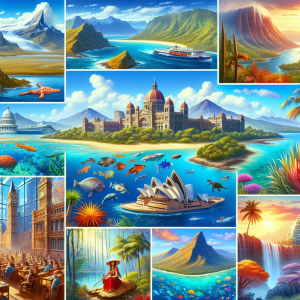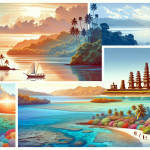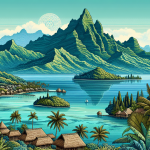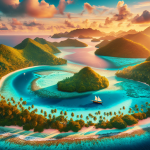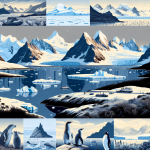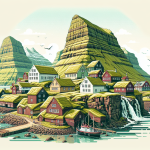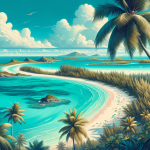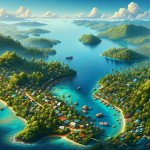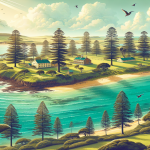Exploring the Wonders of Oceania: A Comprehensive Guide
Oceania, a vast and diverse region encompassing Australasia, Melanesia, Micronesia, and Polynesia, offers an unparalleled array of experiences for travelers. From the rugged outback of Australia to the serene beaches of Fiji, the cultural richness of New Zealand to the vibrant coral reefs of Papua New Guinea, Oceania is a treasure trove of natural beauty and cultural heritage. This comprehensive guide delves into the myriad attractions that Oceania has to offer, providing insights and tips for travelers looking to explore this extraordinary part of the world. Whether you’re an adventure seeker, a culture enthusiast, or someone looking to relax on pristine beaches, Oceania has something for everyone. Join us as we embark on a journey to discover the wonders of Oceania, a destination that promises unforgettable memories and experiences.
Discovering Australasia
Australia’s Natural Wonders
Australia, the largest country in Oceania, boasts a diverse landscape that ranges from arid deserts to lush rainforests. The Great Barrier Reef, one of the seven natural wonders of the world, is a must-visit destination for snorkeling and diving enthusiasts. This underwater paradise is home to a stunning array of marine life and vibrant coral formations. For those who prefer terrestrial adventures, the Outback offers a unique experience with its vast, rugged terrain and rich indigenous culture. Iconic landmarks such as Uluru (Ayers Rock) and Kata Tjuta (The Olgas) provide a glimpse into the spiritual heart of Australia.
New Zealand’s Cultural Riches
New Zealand, known for its breathtaking landscapes and Maori heritage, is a haven for outdoor enthusiasts and culture seekers alike. The Fiordland National Park, with its dramatic fjords and lush rainforests, is a paradise for hikers and nature lovers. The Rotorua region, famous for its geothermal activity and Maori cultural experiences, offers visitors a chance to immerse themselves in the rich traditions and history of the Maori people. Adventure seekers can indulge in activities such as bungee jumping, skydiving, and white-water rafting in Queenstown, the adventure capital of the world.
Exploring Melanesia
Papua New Guinea’s Vibrant Culture
Papua New Guinea, a country known for its cultural diversity and stunning landscapes, is a destination that offers a unique blend of adventure and tradition. The Sepik River region is renowned for its intricate wood carvings and vibrant cultural festivals. Visitors can explore traditional villages, witness mesmerizing tribal dances, and learn about the local customs and traditions. The country’s diverse ecosystems, from lush rainforests to pristine coral reefs, provide ample opportunities for trekking, bird watching, and diving.
Solomon Islands’ Pristine Beauty
The Solomon Islands, an archipelago of over 900 islands, is a paradise for nature lovers and history buffs. The Marovo Lagoon, the world’s largest saltwater lagoon, is a UNESCO World Heritage site known for its crystal-clear waters and abundant marine life. Divers and snorkelers can explore the vibrant coral reefs and WWII shipwrecks that dot the lagoon. The Western Province offers a glimpse into the traditional Melanesian way of life, with its picturesque villages, intricate wood carvings, and cultural festivals.
Discovering Micronesia
Palau’s Underwater Wonders
Palau, a tropical paradise in Micronesia, is renowned for its pristine beaches, crystal-clear waters, and vibrant marine life. The Rock Islands, a UNESCO World Heritage site, are a group of limestone islands that offer some of the best diving and snorkeling experiences in the world. The Jellyfish Lake, a marine lake filled with millions of harmless jellyfish, provides a unique and unforgettable snorkeling experience. Palau’s rich cultural heritage, with its traditional bai (meeting houses) and ancient stone carvings, offers a glimpse into the island’s history and traditions.
Federated States of Micronesia’s Rich History
The Federated States of Micronesia (FSM), a country comprising four states spread across the western Pacific Ocean, is a destination that offers a unique blend of natural beauty and cultural heritage. The Nan Madol, an ancient city built on a series of artificial islets, is a UNESCO World Heritage site that offers a fascinating glimpse into the island’s history and architecture. The Chuuk Lagoon, a haven for wreck diving enthusiasts, is home to dozens of WWII shipwrecks that have become thriving artificial reefs.
Exploring Polynesia
French Polynesia’s Romantic Escapes
French Polynesia, an overseas territory of France, is renowned for its idyllic islands, crystal-clear waters, and luxurious overwater bungalows. The Bora Bora Island, often referred to as the “Jewel of the South Seas,” is a popular honeymoon destination known for its stunning lagoons and vibrant coral reefs. The Tahiti Island, the largest island in French Polynesia, offers a perfect blend of natural beauty and cultural experiences. Visitors can explore the island’s lush valleys, black-sand beaches, and traditional Polynesian temples.
Samoa’s Authentic Island Experience
Samoa, an island nation in Polynesia, offers a unique and authentic island experience. The Upolu Island, home to the capital city of Apia, is known for its pristine beaches, lush rainforests, and vibrant cultural heritage. The To Sua Ocean Trench, a natural swimming hole surrounded by tropical gardens, is a must-visit attraction for nature lovers. The Samoan Fales, traditional open-air houses, offer visitors a chance to experience the island’s traditional way of life.
Practical Tips for Traveling in Oceania
Best Time to Visit
The best time to visit Oceania largely depends on the specific destinations within the region. Generally, the southern hemisphere summer (December to February) is ideal for visiting Australia and New Zealand, while the dry season (May to October) is the best time to explore the islands of Melanesia, Micronesia, and Polynesia. Be sure to research the climate and weather patterns of your chosen destinations to ensure a pleasant and enjoyable trip.
Visa and Entry Requirements
Visa and entry requirements for Oceania vary depending on the country of origin and the specific destination within the region. Travelers should check the visa requirements for each country they plan to visit and ensure they have the necessary documentation before departure. Many countries in Oceania offer visa-free or visa-on-arrival options for short stays, but it is essential to verify the requirements in advance.
Health and Safety
When traveling to Oceania, it is important to take necessary health precautions and stay informed about any potential health risks. Travelers should ensure they are up to date on routine vaccinations and consider additional vaccines or medications based on their specific destinations. It is also advisable to carry a basic first aid kit and any necessary prescription medications. In terms of safety, Oceania is generally a safe region for travelers, but it is always wise to exercise common sense and take necessary precautions to avoid any potential risks.
Sustainable Travel in Oceania
Supporting Local Communities
One of the best ways to practice sustainable travel in Oceania is by supporting local communities. Travelers can choose to stay in locally-owned accommodations, dine at local restaurants, and purchase souvenirs from local artisans. Engaging with local communities and learning about their cultures and traditions not only enriches the travel experience but also helps to support the local economy.
Preserving Natural Environments
Oceania is home to some of the world’s most pristine natural environments, and it is important for travelers to take steps to preserve these treasures. Travelers should practice responsible tourism by following guidelines for wildlife interactions, staying on designated trails, and minimizing waste. Supporting eco-friendly tours and activities that prioritize conservation and sustainability is also an excellent way to contribute to the preservation of Oceania’s natural beauty.
Reducing Carbon Footprint
Traveling to Oceania often involves long-haul flights, which can contribute to a significant carbon footprint. Travelers can mitigate their impact by offsetting their carbon emissions through reputable carbon offset programs. Additionally, choosing sustainable transportation options, such as public transportation, biking, or walking, can help reduce the overall environmental impact of the trip.
Conclusion
Oceania, with its diverse landscapes, rich cultural heritage, and stunning natural beauty, is a destination that promises unforgettable experiences for travelers. From the rugged outback of Australia to the serene beaches of French Polynesia, the vibrant coral reefs of Papua New Guinea to the ancient ruins of Micronesia, Oceania offers something for everyone. By following the tips and insights provided in this guide, travelers can embark on a journey to discover the wonders of Oceania while practicing sustainable and responsible tourism. Whether you’re seeking adventure, relaxation, or cultural immersion, Oceania is a destination that will leave you with lasting memories and a deeper appreciation for the beauty and diversity of our world.
For more travel inspiration and tips, visit Lonely Planet.
